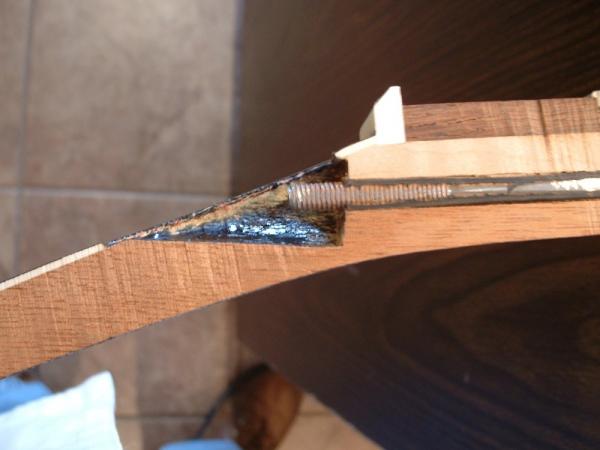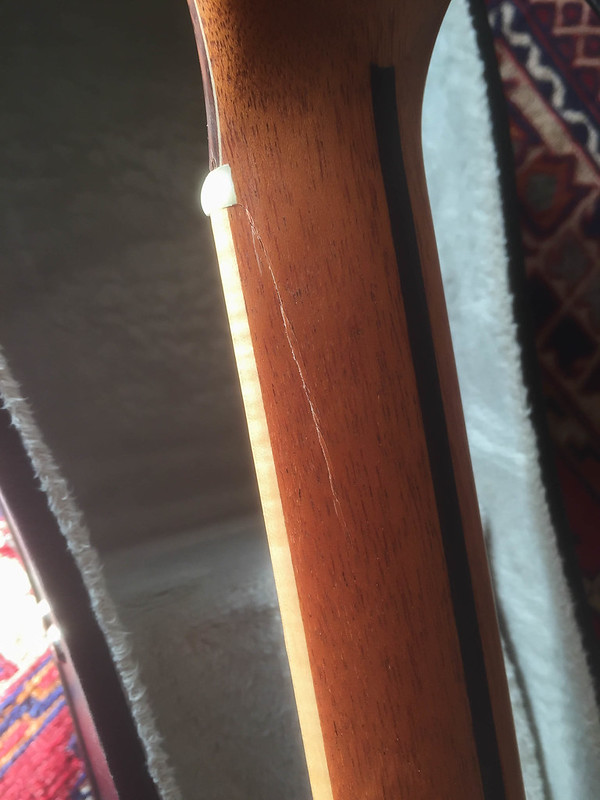You are using an out of date browser. It may not display this or other websites correctly.
You should upgrade or use an alternative browser.
You should upgrade or use an alternative browser.
Guitar talk: acoustic, bass, classical, twelve string? You name it! Pt III
- Thread starter Seeker_UK
- Start date
matthewr
spɹɐʍʞɔɐq spɹoɔǝɹ ɹnoʎ sʎɐld
Looks like a Rick of some description.
Yeah definitely a Rick -- can be seen here : https://tinyurl.com/2fcpre6
gavreid
Pretty Words...
Problem = string break angle on Gibson-style heads.
Solution? String Butler, apparently.
or just file the nut correctly
windhoek
The Phoolosopher
or just file the nut correctly
By correctly, do you mean filing the nut so that the slots run towards the machine heads at the appropriate angles? Filing the nut in this way may well reduce the break angles to negligible levels, but it introduces sharp bends on the fretboard side of the nut - break angles have to be introduced somewhere and if not on one side of the nut, then it must be the other.
From what the guy in the video is saying, inserting rollers between the nut and machine heads reduces friction, which in turn, allows for better tuning stability - even when the break angle is more acute than it would otherwise be without the String Butler.
I'm not suggesting the String Butler is at all necessary, I'm not convinced there's enough of a problem that needs solving in this manner, but the mechanics of it seem intuitively correct all the same i.e. lining-up strings with machine heads via low friction rollers is better than lining-up strings with machine heads with via high(er) friction angled slots in the nut
Yank
Bulbous Also Tapered
Don’t know about the Watkins but that Fender stack is absolutely gorgeous, major GAS!
Is that a Bassman?
Yes, a 6G6-A.
gavreid
Pretty Words...
By correctly, do you mean filing the nut so that the slots run towards the machine heads at the appropriate angles? Filing the nut in this way may well reduce the break angles to negligible levels, but it introduces sharp bends on the fretboard side of the nut - break angles have to be introduced somewhere and if not on one side of the nut, then it must be the other.
Sure it's a bit of a compromise but it really isn't much of a problem having 3 a-side machines...
windhoek
The Phoolosopher
Sure it's a bit of a compromise but it really isn't much of a problem have 3 a-side machines...
Agreed. It may be a theoretical improvement, but for most guitars it won't be needed. That said, the guy said it solved his tuning issues so we can only take his word for it that it was needed on that particular guitar. I do like the concept though as it does make sense and in some ways, it's the same as having a string tree on Fender-style guitars, except that the branches are horizontal and simply rounded with no rotation.
gavreid
Pretty Words...
Agreed. It may be a theoretical improvement, but for most guitars it won't be needed. That said, the guy said it solved his tuning issues so we can only take his word for it that it was needed on that particular guitar. I do like the concept though as it does make sense and in some ways, it's the same as having a string tree on Fender-style guitars, except that the branches are horizontal and simply rounded with no rotation.
I'd be reluctant to add any weight to the headstock but from an engineering perspective it should be fine
-alan-
pfm Member
Alternatively with a Les Paul just wait for the headstock to snap off, which it likely will, and then get it glued back at a more sensible angle!
(And surely only those old-fashioned Gibson versions of the Lester..you don't get that nonsense on a properly shaped Tokai one ..)
gavreid
Pretty Words...
I had a brand new acoustic (not a Gibson) arrive with a broken headstock, despite it being in a hardcase. If you drop them or throw them about under tension it's always a risk. It's the nature of the 1-piece mahogany neck in general, and the small amount of material in the vicinity of the truss rod access hole or just the truss rod channel in the case of my acoustic. A scarf jointed neck or a multi-ply neck would have been an inherently stronger design.
-alan-
pfm Member

It's amazing there are any left that haven't broken.
The stress concentration around that 90 degree cut must be huge. Can't see any way to avoid it whilst you still need a truss-too nut alas.
True, though the hole wouldn't need to be anywhere near that large if Gibson used an allen nut like Fender instead of a nut where there has to be space for the spanner/socket on the outside.Can't see any way to avoid it whilst you still need a truss-too nut alas.
gavreid
Pretty Words...
The stress concentration around that 90 degree cut must be huge. Can't see any way to avoid it whilst you still need a truss-too nut alas.
It's the orientation of the grain in that area that's the issue, I think, much of if is exposed end grain and there's little strength. When the necks break, the 'layers' of wood separate from each other rather than just snapping straight across the cutout. My acoustic had the same kind of break, only in the other direction, although the truss rod access was through the sound hole.

matthewr
spɹɐʍʞɔɐq spɹoɔǝɹ ɹnoʎ sʎɐld
For a mere £1850 Fender will take one of the pickups out of a Telecaster for you.
https://www.andertons.co.uk/brands/...der-70th-anniversary-esquire-lake-placid-blue
https://www.andertons.co.uk/brands/...der-70th-anniversary-esquire-lake-placid-blue
Tony L
Administrator
If I was in the market for a new Tele I could be swayed by the ltd edition Broadcaster reissue. Looks like a proper Tele but should hold its value well given the name.

